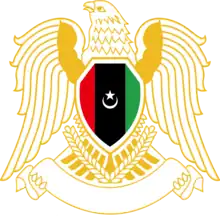Libyan National Army
The Libyan National Army (LNA; Arabic: الجيش الوطني الليبي, al-jaysh al-waṭaniyy al-Lībii) or the Libyan National Arab Army (LNAA; Arabic: الجيش الوطني العربي الليبي, al-jaysh al-waṭaniyy al-'Arabiyy al-Lībii)[2] is a component of Libya's military forces which were nominally a unified national force under the command of Field Marshal Khalifa Haftar when he was nominated to the role on 2 March 2015[6] by the House of Representatives, consisting at the time of a ground force, an air force and a navy.
| الجيش العربي الليبي | |
 Emblem used in official meetings[5] | |
| Active | 1951 (Cyrenaica Liberation Army) 2014 (current form) |
| Country | |
| Allegiance | House of Representatives |
| Size | 100,000+ |
| Garrison/HQ | Tobruk |
| Engagements | Factional violence in Libya (2011–2014) Second Libyan Civil War |
| Commanders | |
| Commander-in-chief | Mohamed al-Menfi |
| Supreme Commander | Field Marshal Khalifa Haftar |
| Chief of General Staff | Lieutenant General Abdulrazek al-Nadoori |
| Insignia | |
| Flag of the LNA [5] | .svg.png.webp) |
In 2014, LNA launched Operation Dignity, a military campaign against the General National Congress and armed militias and Islamist militant organizations. When the internationally recognised Government of National Accord (GNA) was established in Tripoli, part of the Libyan military forces were named the Libyan Army to contrast with the other part that retained the LNA identity. In the Second Libyan Civil War, the LNA is loyal to that part of the Libyan House of Representatives that meets in Tobruk, internationally recognised until October 2015. It fights against the Shura Council of Benghazi Revolutionaries, as well as Islamic State in Libya which is a common enemy for both LNA and the Libyan Army.
About half of the LNA consists of militias[1][7] including Madkhali (Salafist) militias[8] and Sudanese, Chadian[1][7] and Russian mercenaries, which together constitute part of the LNA's effective forces.[9] The LNA possesses its own air force. Most of the Libyan Navy is loyal to the GNA.[10][7]
Interventions in the political system by the LNA include the late 2016 replacement of nine elected municipal councils out of a total of 27, replacing elected mayors by mostly military individuals[11][12][13] and, according to witnesses cited by The Independent, the 17 July 2019 abduction of House of Representatives member Seham Sergiwa at her home in Benghazi by the 106th Brigade.[14][15] The LNA stated that it was not responsible for the Sergiwa abduction.[14]
Name
In November 2019, the United Nations Panel of Experts on Libya established under United Nations Security Council Resolution 1973 started using the name Haftar Armed Forces (HAF) to replace the name Libyan National Army to refer to "all armed groups associated with Haftar". It also chose to use lower case regarding "brigades" and "battalions" in order to avoid giving them "the legitimacy of being a formed military unit of a government".[4]: 6
Allies
Haftar and the LNA is de facto backed by the governments of Egypt, Russia and the United Arab Emirates.[16][17][18][19][20] France has also provided tacit backing for Haftars forces. France carried out unprecedented air strikes by its Airforce on Chadian opposition fighters, which are LNA's biggest opponents. This resulted in a public dispute with Italy, which is supporting the Government of National Accord (GNA) in Tripolis.[17]
Russia is Haftar's most committed ally. In May 2020 the US Africa Command (AFRICOM) stated that Russia had deployed at least 14 MiG planes to the country. The plans were supported by private military contractors of Wagner Group and supporting the LNA.[21][22][23]
Structure
- ground forces
- regular forces
- Special Forces
- military intelligence
- militias
- foreign units
- LNA component of the Libyan Air Force
- naval forces: coastal patrol vessels[7]
Ranks
Leadership
Khalifa Haftar was made head of the armed forces of Libya on 2 March 2015,[6] remaining as leader of the Libyan National Army after the split between the LNA and the Government of National Accord (GNA). As of December 2017, Major General Abdulrazek al-Nadoori was the chief of staff of the LNA.[24] A lobbying firm was paid US$450,000 to lobby on his behalf for 12 months, starting 1 December 2017, in Washington, D.C.[24] Mahmoud al-Werfalli, known internationally for his International Criminal Court arrest warrant under Article 8(2)(c)(i) of the Rome Statute, was Axes Commander in the al-Saiqa unit of the LNA as of August 2017.[25][26]
Other senior leaders include:
- Commander-in-chief Aguila Saleh Issa (President of the Libyan House of Representatives).
- Supreme commander Field Marshal Khalifa Haftar.
- Chief of Staff of the Libyan Air Force Major General Saqr Geroushi.
- Military intelligence Major General Ramadan Atiat-Allah.
- Libyan Special Forces Major General Wanis Bukhamada.
- Head of Operations Major General Abdulsalam al-Hasy.
- Official Spokesperson of the LNA Major General Ahmed al-Mesmary.
- Head of Darna operations room Major General Salim al-Rifady al-Obaidy.
Ground forces
Regular forces
As of May 2019, the LNA had about 7000 regular forces.[7] These include:
106th Brigade
In April 2019, the 106th Brigade, also known as Awlia Aldem (Arabic: أوليء الدم)[15][14] was led by Khaled, son of Khalifa Haftar.[27] As of June 2019, the brigade's commander was Salem Rahil.[28]
On 17 July 2019, according to witnesses cited by The Independent and a family member cited by CNN, 25–30 masked, uniformed 106th Brigade members abducted member of the Libyan House of Representatives Seham Sergiwa in Benghazi.[14][15] The LNA stated that it was not responsible for the abduction.[14] As of 17 October 2019, after multiple calls by UNSMIL for the LNA to investigate the disappearance, Sergiwa remained missing.[29]
73rd Brigade Mechanized infantry
Leader: Saleh al-Quta'ani (Aug 2019)[27]
Tareq ben Ziyad Brigade
Leader: Omar Mraje' (Aug 2019)[27]
128th Battalion
Leader: Hassan al-Zadma; many Mahamid members (Aug 2019)[27]
116th Battalion
Leader: Massoud Jiddu (Aug 2019)[27]
124th Brigade
Leader:
309th Brigade Mechanized infantry
Leader:
1st Brigade
Leader:
166th Brigade Mechanized infantry
Leader:
188th Brigade infantry
Leader:
5th Brigade infantry
Leader:
115th Brigade Mechanized infantry
Leader:
82nd Brigade infantry
Leader:
Special forces
Al-Saiqa is an elite army unit, formed from a mixture of paratroopers and commandos. It numbers a few thousand and reports to the Ministry of Defence. It is popular in Benghazi, particularly in light of its opposition to Islamist Ansar al-Sharia group and because it is seen as a symbol of the reborn Libyan armed forces.[30]
Militias
Madkhali militias in the LNA include the Tawhid Battalion commanded by Izz al-Din al-Tarhuni; the Tariq Ibn Ziyad Brigade, the Subul al-Salam group and the al-Wadi Brigade.[31] LNA groups from Sabratha, Sorman, Tiji and Badr, towns in which Madkhali preachers were active and supported Haftar, are mostly Madkhali Salafists.[27]
During the 2019–20 Western Libya campaign, the LNA was allied with the al-Kaniyat militia in Tarhuna.[32][33][34][35][36]
The number of auxiliary LNA forces (militias and mercenaries) was estimated in May 2019 as 18000 by Jason Pack of the Institute for International Political Studies.[7]
Foreign mercenaries
Foreign mercenaries operating during 2019 Western Libya offensive on behalf of the LNA include Sudanese, Chadians and Russians.[31]
Sudanese from the Sudan Liberation Movement/Army (Minnawi) were present in Libya starting in March 2015 and fought on behalf of the LNA in 2016. SLM (Minnawi) planned on leaving Libya in early 2017.[37]: 115 Sudan Liberation Movement/Army (al-Nur) fighters fought on behalf of the LNA, with 1500 personnel in Libya in mid-2016.[37]: 115 Involvement of Sudanese mercenaries continued in 2018.[38]: 9, 79, 80 On 25 July 2019, 1000 members of the Sudanese Rapid Support Forces, widely attributed to be responsible for the 3 June 2019 Khartoum massacre,[39] arrived in Libya and were expected to number 4000 in total.[40]
Chadians from the Rally of Democratic Forces (French: Rassemblement des Forces Démocratique) were recruited by the LNA in late 2015,[1] especially in the southern part of Libya.[31]
There were an estimated 200 Russian Wagner Group mercenaries in the LNA in 2019.[35][34][33][32][36]
On 1 January 2022, the 5+5 Libyan Joint Military Commission announced the deportation of 300 Sudanese mercenaries linked to the LNA from the Eastern Region.[41]
History
2011–2013
The Libyan National Army was founded in 2011 by the National Transitional Council, after forces aligned to it defeated the previous Libyan Army and overthrew Muammar Gaddafi's government. Supply depots and bases having been damaged during the civil war, the new army is faced with the challenge of having to rebuild much of the country's military infrastructure.[42] Yousef Mangoush was named as its first Chief of Staff on 2 January 2012 and the force saw its first major deployment on 23 February, when it was deployed to Kufra to intervene in a tribal conflict.[43]
In November 2011, the National Transitional Council began the difficult process of restructuring the army, with military personnel who defected from the Gaddafi government and former rebel fighters of the National Liberation Army forming the basis of the new Libyan Army. Major General Khalifa Belgacem Haftar was chosen as the overall commander of the new Libyan Army due to his military experience and loyalty to the revolution that overthrew Gaddafi.[44]
The Libyan Army only numbered "a few thousand" trained soldiers in November 2011, and was rapidly trying to train up new fighters who could keep the peace nationwide and deter rogue militias from acting without NTC orders, and was responsible for brokering a ceasefire on at least one occasion in November between warring militas from Zawiya and Al Maya.[45]
On 1 December 2011, it was reported that the National Liberation Army was to integrate up to 50,000 former rebel fighters into the new Libyan national army and police forces, with the aid of French training, with long-term aims to integrate as many as 200,000 fighters from the brigades that had fought against Gaddafi during the civil war.[46]
In December 2011, Italy agreed to provide training to the Libyan Army as it attempted to reorganize in the aftermath of the Civil War.[47][48]
Also in December, large numbers of former rebels were being given jobs in the new army, whilst the government also announced that they would be free to join the special forces and the Navy too. According to Osama al-Juwaili, the defence minister: "The idea is to inject new blood in the army which was marginalised by the tyrant (Gaddafi)"[49]
General Yousef Mangoush said on 5 January 2012 that Libya's new army faces major obstacles such as rebuilding bases destroyed during the conflict, as well as disarming militias that were not part of the new army. National Army commander General Khalifa Haftar said later that it could take between three and five years for Libya to field a capable enough army to protect its borders.[50]
On 7 May 2013, Libya's Defense Minister Mohammed al-Barghathi resigned due to a crisis caused by gunmen who have besieged two ministries for more than a week, a ministry official said. He later withdrew his resignation after Prime Minister Zeidan convinced him to stay.[51]
Under an agreement reached at the Lough Erne G8 summit in June 2013, NATO countries the United Kingdom, Italy, Turkey, and the United States undertook to help train up to 15,000 personnel from Libyan National Army units over a two-year period. They were to take units from newly formed brigades for 10-week stints of intensive infantry training. The 27th Brigade was due to start at Bassingbourn in eastern England in January 2014.[52] As a result of disorder and sexual assaults by some Libyan army cadets, the UK cancelled the programme in November 2014. The Libyan trainees were sent back to Libya, with the exception of five who were tried for sexual offenses.[53]
2016 overthrow of mayors
In late 2016, Major-General Abdulrazek al-Nadoori of the LNA replaced several of the elected municipal mayors in eastern Libya by unelected people, mostly military.[11][12] Altogether the LNA replaced nine elected councils, out of 27 in its area of control, by military administrators.[13]
Equipment

Whilst it is known to a degree what equipment the Libyan National Army uses, the exact numbers of the below equipment currently in use is not known. What is certain is that a reasonable quantity of their equipment probably came from ransacked stocks of the original Libyan Army and from defectors as well. A significant amount of arms and equipment possessed by the LNA were majorly shipped by the United Arab Emirates and Russia. Having an airbase in Libya (Al-Khadim), the UAE constantly breached the UN arms embargo to transfer arms to the Haftar forces. An Emirati firm, Lancaster-6 was involved in transferring three Super Pumas to the LNA in June 2019. The helicopters were believed to be incapable to operate. The three helicopters remained inside hangars until Haftar's military parade in May 2021 and were expected to take part in his air force.[54]
Technicals
A variety of pickup/utility vehicles, called technicals and gun trucks, often Toyota and other makers, armed with a variety of different weapons, including heavy machine guns, light MLRS' and anti-aircraft guns, most commonly used is the ZU-23-2 and the ZPU.[55][56]
Tanks
Armoured personnel carriers
 Soviet Union – BTR-60
Soviet Union – BTR-60 Soviet Union – BRDM-2[62]
Soviet Union – BRDM-2[62] Soviet Union – BMP-1
Soviet Union – BMP-1 Russia – BMP-3 – 10 delivered in 2013[63]
Russia – BMP-3 – 10 delivered in 2013[63] United Arab Emirates – Nimr – 169 in service[64]
United Arab Emirates – Nimr – 169 in service[64] United Arab Emirates – Panthera F9 – Received from UAE
United Arab Emirates – Panthera F9 – Received from UAE Italy – Puma 4×4 – 20 donated by Italy[65]
Italy – Puma 4×4 – 20 donated by Italy[65] United States – M1151 HMMWV – 200 donated by the U.S. Army[66]
United States – M1151 HMMWV – 200 donated by the U.S. Army[66]
Artillery
 Soviet Union – BM-21 Grad – Multiple Rocket Launch System[67]
Soviet Union – BM-21 Grad – Multiple Rocket Launch System[67] Serbia – LRSVM Morava[68]
Serbia – LRSVM Morava[68] China – Type 63 multiple rocket launcher[56]
China – Type 63 multiple rocket launcher[56]
Portable anti-tank weapons
 Sweden – Carl Gustav recoilless rifle[56]
Sweden – Carl Gustav recoilless rifle[56] United States – M40 recoilless rifle[56]
United States – M40 recoilless rifle[56].svg.png.webp) Yugoslavia – M79 Osa[69]
Yugoslavia – M79 Osa[69] Soviet Union – RPG-7 – In widespread use by all factions in the conflict.
Soviet Union – RPG-7 – In widespread use by all factions in the conflict. China – Type 69 RPG[70]
China – Type 69 RPG[70]
Anti-tank guided missiles
 France /
France /  West Germany – MILAN – From government stocks. Some were supplied by Qatar during the 2011 Libyan Civil War.[71]
West Germany – MILAN – From government stocks. Some were supplied by Qatar during the 2011 Libyan Civil War.[71] Soviet Union – AT-3 "Sagger" – From government stocks.[56]
Soviet Union – AT-3 "Sagger" – From government stocks.[56] Soviet Union – AT-4 "Spigot" – From government stocks.
Soviet Union – AT-4 "Spigot" – From government stocks. Soviet Union – AT-5 "Spandrel" – From government stocks.
Soviet Union – AT-5 "Spandrel" – From government stocks. Russia – AT-14 "Spriggan" – From government stocks.[72] Some Iranian-made copies are also used.[73]
Russia – AT-14 "Spriggan" – From government stocks.[72] Some Iranian-made copies are also used.[73] United States – FGM-148 Javelin – Transferred from France.[74]
United States – FGM-148 Javelin – Transferred from France.[74]
Self-propelled anti-air gun
UAVs
Small arms
 Russia – AK-103 – assault rifle.
Russia – AK-103 – assault rifle. Bulgaria – AR-M1 – assault rifle.[76]
Bulgaria – AR-M1 – assault rifle.[76] China – Type 56 – assault rifle[70]
China – Type 56 – assault rifle[70] Soviet Union – AK-47 – assault rifle.
Soviet Union – AK-47 – assault rifle. Soviet Union – AKM – assault rifle.
Soviet Union – AKM – assault rifle. Soviet Union – AK-74 – assault rifle
Soviet Union – AK-74 – assault rifle Soviet Union – RPK – light machine gun.
Soviet Union – RPK – light machine gun. Soviet Union – PK – general-purpose machine gun.
Soviet Union – PK – general-purpose machine gun. China – Type 80 – general-purpose machine gun[70]
China – Type 80 – general-purpose machine gun[70] Soviet Union – DShK – heavy machine gun.
Soviet Union – DShK – heavy machine gun.
Notes
References
- Delalande, Arnaud (28 May 2018). "Forces on the Libyan ground: Who is Who". ISPI. Archived from the original on 20 November 2019. Retrieved 20 November 2019.
- Eaton, Tim (15 January 2020). "Russia and Turkey failed to mediate peace in Libya. What happens now?". The Washington Post. Archived from the original on 11 February 2020. Retrieved 11 February 2020.
- Herbert, Matthew (8 October 2019). "Libya's war becomes a tech battleground". This Is Africa. Archived from the original on 11 February 2020. Retrieved 11 February 2020.
- Majumdar Roy Choudhury, Lipika; de Alburquerque Bacardit, Luis Antonio; Kadlec, Amanda; Kartas, Moncef; Marjane, Yassine; Wilkinson, Adrian (29 November 2019). "Final report of the Panel of Experts on Libya established pursuant to Security Council resolution 1973 (2011)" (PDF). United Nations Security Council. Archived (PDF) from the original on 28 January 2020. Retrieved 28 January 2020.
- "Haftar agrees to Libya ceasefire ahead of Berlin talks". Middle East Online. 16 January 2020. Retrieved 7 January 2020.
- "Libyan parliament confirms Haftar as army chief". Al Jazeera. 2 March 2015. Archived from the original on 4 March 2015. Retrieved 3 March 2015.
- Pack, Jason (31 May 2019). "Kingdom of Militias: Libya's Second War of Post-Qadhafi Succession". ISPI. Archived from the original on 29 June 2019. Retrieved 9 November 2019.
- "Sirte falls to Haftar's forces, thanks to a Madkhali brigade from the inside | The Libya Observer". libyaobserver.ly. Retrieved 6 January 2020.
- Burke, Jason; Salih, Zeinab Mohammed (24 December 2019). "Mercenaries flock to Libya raising fears of prolonged war". the Guardian. Archived from the original on 27 December 2019. Retrieved 7 January 2020.
- Abdullah, Walid; Aytekin, Emre (27 August 2019). "5 migrants die, 65 others rescued off Libyan coast". Anadolu Agency. Archived from the original on 9 November 2019. Retrieved 9 November 2019.
- Talbot, Frank; Denehy, David (13 December 2018). "Is it time for municipal elections in Libya?". Institute for International Political Studies. Archived from the original on 20 April 2019. Retrieved 21 April 2019.
- "Serraj condemns eastern suppression of elected mayors". Libya Herald. 3 October 2016. Archived from the original on 20 April 2019. Retrieved 20 April 2019.
- "Project Document – Libya – Local Elections" (PDF). United Nations Development Programme. 4 February 2019. Archived (PDF) from the original on 6 January 2020. Retrieved 1 May 2019.
- Sengupta, Kim (29 July 2019). "Libyan MP and rights campaigner dragged away by masked gunmen after criticising warlord: 'Don't cross the line of the army'". The Independent. Archived from the original on 14 November 2019. Retrieved 14 November 2019.
- Lister, Tim; Bashir, Nada (20 July 2019). "She's one of the most prominent female politicians in her country. A few days ago she was abducted from her house". CNN. Archived from the original on 22 July 2019. Retrieved 22 July 2019.
- "Libya: GNA calls Egypt's military threat 'declaration of war'". Al Jazeera. Retrieved 15 January 2022.
- "Khalifa Haftar: The Libyan general with big ambitions". BBC News. 8 April 2019. Retrieved 15 January 2022.
- Harkov, Lahav (15 January 2022). "Libyan warlord's plane lands in Israel". The Jerusalem Post. Retrieved 22 March 2022.
- Melman, Yossi (15 April 2020). "Israel's little-known support for Haftar's war in Libya". Middle East Eye. Retrieved 22 March 2022.
- "EXCLUSIVE: Israeli military 'secretly training' Libya's Haftar militias in street warfare". The New Arab. 7 December 2019. Retrieved 22 March 2022.
- "Russia expands war presence in Libya". DW. 29 May 2020. Retrieved 15 January 2022.
- Waxelbaum, Judah (3 August 2020). "Russia moves to secure its investment in Libya". The Jerusalem Post. Retrieved 15 January 2022.
- Barmin, Yury (11 July 2019). "Russia's endgame in Libya". Al Jazeera. Retrieved 15 January 2022.
- Fornaji, Hadi (12 December 2017). "Nazhuri employs Washington lobbyist". Libya Herald. Archived from the original on 22 April 2019. Retrieved 23 April 2019.
- "ICC-01/11-01/17: The Prosecutor v. Mahmoud Mustafa Busayf Al-Werfalli Warrant of Arrest" (PDF). International Criminal Court. 15 August 2017. Archived (PDF) from the original on 15 April 2019. Retrieved 16 August 2017.
- The Office of the Prosecutor (9 May 2018). "Fifteenth report of the prosecutor of the International Criminal Court to the United Nations Security Council pursuant to UNSCR 1970 (2011)" (PDF). International Criminal Court. Archived (PDF) from the original on 14 April 2019. Retrieved 9 April 2019.
- Lacher, Wolfram (2019). "Who is fighting whom in Tripoli? How the 2019 civil war is transforming Libya's military landscape" (PDF). Security Assessment in North Africa Briefing Paper. Archived from the original (PDF) on 10 November 2019. Retrieved 11 November 2019.
- "اللواء رحيل: هناك تنسيق بين الإرهابيين في مدينتي طرابلس ودرنة" [MAjor General Rahil: There is coordination between the terrorists in the cities of Tripoli and Derna]. al-Marsad (Arabic: صحيفة المرصد الليبية) (in Arabic). 3 June 2019. Archived from the original on 22 January 2020. Retrieved 22 January 2020.
- "Three months after the kidnapping of MP Sergewa, UNSMIL calls for her immediate releases and all victims of enforced disappearance in Libya". UNSMIL. 17 October 2019. Archived from the original on 8 November 2019. Retrieved 8 November 2019.
- "Guide to key Libyan militias and other armed groups". BBC. 28 November 2013. Archived from the original on 3 July 2019. Retrieved 20 June 2018.
- el-Gamaty, Guma (7 November 2019). "Militias and mercenaries: Haftar's army in Libya". Middle East Eye. Archived from the original on 9 November 2019. Retrieved 9 November 2019.
- "From Tripoli's front lines: How Haftar recovered from the setback in Gharyan and what's next for the advancing LNA".
- Wehrey, Frederic (5 December 2019). "With the Help of Russian Fighters, Libya's Haftar Could Take Tripoli".
- "Arrival of Russian mercenaries adds deadlier firepower, modern tactics to Libya's civil war". Washington Post.
- Kirkpatrick, David D. (5 November 2019). "Russian Snipers, Missiles and Warplanes Try to Tilt Libyan War". The New York Times.
- Kirkpatrick, David D. (5 November 2019). "Russian Snipers, Missiles and Warplanes Try to Tilt Libyan War - The New York Times". The New York Times.
- Majumdar Roy Choudhury, Lipika; Abou-Khalil, Naji; Bouhou, Kassim; Kartas, Moncef; McFarland, David; de Alburquerque Bacardit, Luis Antonio (1 June 2017). "Final report of the Panel of Experts on Libya established pursuant to resolution 1973 (2011)" (PDF). United Nations Security Council. S/2017/466. Archived from the original on 20 November 2019. Retrieved 20 November 2019.
- Spittaels, Steven; Abou-Khalil, Naji; Bouhou, Kassim; Kartas, Moncef; McFarland, David; Pintos Servia, Juan Alberto (5 September 2018). "Final report of the Panel of Experts on Libya established pursuant to resolution 1973 (2011)" (PDF). United Nations Security Council. S/2018/812. Archived from the original on 20 November 2019. Retrieved 20 November 2019.
- Lynch, Justin (5 June 2019). "Remember The Darfur Genocide? With Saudi Help, One of the Killer Commanders There Is Taking Over Sudan". The Daily Beast. Archived from the original on 7 June 2019. Retrieved 8 June 2019.
- "1,000 Sudanese militiamen arrive in Libya". Radio Dabanga. 25 July 2019. Archived from the original on 26 July 2019. Retrieved 26 July 2019.
- "JMC announces deportation of 300 mercenaries belong to Haftar's forces | The Libya Observer". www.libyaobserver.ly. Retrieved 1 January 2022.
- "Libya's new military chief to disarm former rebels". USA Today. 4 January 2012. Archived from the original on 5 March 2016. Retrieved 24 May 2012.
- "New Libya army flexes muscles to halt tribal fight". Reuters. 23 February 2012. Archived from the original on 24 September 2015. Retrieved 24 May 2012.
- "Libya: New Chief for Revamped National Army". AllAfrica.com. 17 November 2011. Retrieved 5 February 2013.
- Krauss, Clifford (21 November 2011). "Libyas toughest test may be building an army". The New York Times. Archived from the original on 18 February 2019. Retrieved 7 December 2013.
- "Libya says to integrate 50,000 anti kadhafi fighters". Morocco World News. 1 December 2011. Retrieved 20 May 2020.
- "Turkey to Train Libya's Army". Turkishweekly.net. Archived from the original on 12 December 2013. Retrieved 7 December 2013.
- "Turkey to Train Libya's Army « Shabab Libya". Shabablibya.org. Archived from the original on 29 November 2014. Retrieved 5 February 2013.
- "Former Libyan rebels offered military jobs". The Daily Telegraph. London. 26 December 2011. Archived from the original on 18 February 2019. Retrieved 3 April 2018.
- "Libya army chief of staff wants to disarm fighters". Zeenews.india.com. 5 January 2012. Archived from the original on 18 February 2019. Retrieved 5 January 2012.
- "Libyan defence chief reverses move to quit, gunmen press siege". English.alarabiya.net. 7 May 2013. Archived from the original on 15 April 2019. Retrieved 7 December 2013.
- "UK trains Libyan army in fight against al-Qaida and warlords". The Observer. Archived from the original on 11 November 2019. Retrieved 29 December 2013.
- "Libyan troops sent home after sexual assault allegations". The Guardian. 5 November 2014. Archived from the original on 27 October 2018. Retrieved 15 December 2016.
- "How Haftar resurrected his three Super Pumas". African Intelligence. July 2021. Retrieved 1 July 2021.
- "A rebel fighter celebrates as his comrades fire a rocket barrage toward Gaddafi forces west of Ajdabiyah, Libya, April 14, 2011". Atlantic Council. 14 April 2011. Archived from the original on 27 May 2013. Retrieved 5 February 2013.
- "Libya: How the opposing sides are armed". BBC News. 23 August 2011. Archived from the original on 8 April 2019. Retrieved 5 February 2013.
- "Libya rebels make gains towards Tripoli". Channel 4 News. 18 August 2011. Archived from the original on 19 June 2019. Retrieved 5 February 2013.
- Jonathan Marcus (10 March 2011). "Gaddafi loyalists mount onslaught". BBC. Archived from the original on 8 April 2019. Retrieved 11 March 2011.
- "Libya: Rebels fight street battles in Zawiya". BBC News. 19 August 2011. Archived from the original on 3 February 2016. Retrieved 20 August 2011.
- "Libyan Interim Forces Await Decision to Attack". English.alarabiya.net. 5 September 2011. Archived from the original on 12 October 2017. Retrieved 11 November 2011.
- David Zucchino (31 March 2011). "Libya fighting: Libya rebels flee eastward by the hundreds". Los Angeles Times. Archived from the original on 21 October 2012. Retrieved 5 February 2013.
- "Who Are the Rebels Fighting Libyan Government Forces?". Voanews.com. 29 March 2011. Archived from the original on 3 February 2016. Retrieved 5 February 2013.
- "Russians deliver armoured fighting vehicles". Libya Herald. Archived from the original on 14 September 2018. Retrieved 7 December 2013.
- "Libya has taken delivery of 49 NIMR 4x4 light tactical armoured vehicles from Jordan 2502133 – Army Recognition". Armyrecognition.com. Archived from the original on 8 April 2019. Retrieved 7 December 2013.
- "Libya has received 20 Italian-made Puma wheeled armoured vehicles personnel carrier Italy 0303131 – Army Recognition". Armyrecognition.com. Archived from the original on 14 September 2018. Retrieved 7 December 2013.
- "Libyan army has taken delivery of 200 HMMWV Humvees from United States 3007131 – Army Recognition". Armyrecognition.com. Archived from the original on 28 September 2013. Retrieved 7 December 2013.
- "Libya uprising: The battle on the road to Sirte". BBC News. 25 August 2011. Archived from the original on 3 February 2016. Retrieved 26 August 2011.
- "Srpski raketni sistem "Morava" stigao u Libiju preko Emirata". NOVA portal (in Serbian). 22 November 2020. Retrieved 30 October 2022.
- "Krenuo izvoz pešadijskog naoružanja za Libiju - Ekonomija - Dnevni list Danas". 7 April 2014. Archived from the original on 6 December 2017. Retrieved 17 July 2014.
- "Tracking Arms Transfers By The UAE, Russia, Jordan And Egypt To The Libyan National Army Since 2014". Oryx. Retrieved 10 September 2023.
- Rigual, Christelle (15 December 2014). Armed Groups and Guided Light Weapons: 2014 Update with MENA Focus (Research Note 47). Small Arms Survey. p. 3. Retrieved 13 June 2023.
- Bouckaert, Peter (4 August 2011). "Bombs Away – A look at Qaddafi's arsenal, now in rebel hands". Foreign Policy. Washington D.C. Archived from the original on 28 October 2014. Retrieved 4 March 2017.
- "Anti-tank missile in Libya looks like Iran-produced weapon - U.N." Reuters. 8 December 2020. Retrieved 18 June 2023.
- Lacher, Wolfram (21 August 2019). Who's Fighting Whom in Tripoli: How the 2019 Civil War is Transforming Libya's Military Landscape. Geneva, Switzerland: Small Arms Survey. p. 14. Retrieved 18 June 2023.
- "Libyan National Army Shoots Down Own Chinese-made Wing Loong Drones". www.defenseworld.net. Retrieved 15 January 2022.
- Jenzen-Jones, N.R. "Bulgarian AR-M9 and AR-M9F Rifles Supplied by UAE to Allied Forces – Small Arms Defense Journal". Small Arms Defense Journal. Retrieved 8 June 2023.
 This article incorporates text from this source, which is in the public domain. Country Studies. Federal Research Division.
This article incorporates text from this source, which is in the public domain. Country Studies. Federal Research Division.
